Subaru Legacy: Tire information
 Subaru Legacy: Tire information
Subaru Legacy: Tire information
- Tire labeling
- Recommended tire inflation pressure
- Glossary of tire terminology
- Tire care – maintenance and safety practices
- Vehicle load limit – how to determine
- Determining compatibility of tire and vehicle load capacities
- Adverse safety consequences of overloading on handling and stopping and on tires
- Steps for Determining Correct Load Limit
Tire labeling
Many markings (e.g. Tire size, Tire Identification Number or TIN) are placed on the sidewall of a tire by tire manufacturers. These marking can provide you with useful information on the tire.
Tire size
Your vehicle comes equipped with P-Metric tire size. It is important to understand the sizing system in selecting the proper tire for your vehicles. Here is a brief review of the tire sizing system with a breakdown of its individual elements.
P Metric
With the P-Metric system, Section Width is measured in millimeters. To convert millimeters into inches, divide by 25.4. The Aspect Ratio (Section Height divided by Section Width) helps provide more dimensional information about the tire size.
Example:

(1) P = Certain tire type used on light duty vehicles such as passenger cars
(2) Section Width in millimeters
(3) Aspect Ratio (= section height 7 section width).
(4) R = Radial Construction
(5) Rim diameter in inches
! Load and Speed Rating Descriptions
The load and speed rating descriptions will appear following the size designation.
They provide two important facts about the tire. First, the number designation is its load index. Second, the letter designation indicates the tire’s speed rating.
Example:

(6) Load Index: A numerical code which specifies the maximum load a tire can carry at the speed indicated by its speed symbol, at maximum inflation pressure.
For example, “91” means 1,356 lbs (615 kg), “90” means 1,323 lbs (600 kg), “89” means 1,279 lbs (580 kg)
WARNING
Load indices apply only to the tire, not to the vehicle. Putting a load rated tire on any vehicle does not mean the vehicle can be loaded up to the tire’s rated load.
(7) Speed Rating: An alphabetical system describing a tire’s capability to travel at established and predetermined speeds.
For example, “V” means 149 mph (240 km/h)
WARNING
● Speed ratings apply only to the tire, not to the vehicle. Putting a speed rated tire on any vehicle does not mean the vehicle can be operated at the tire’s rated speed.
● The speed rating is void if the tires are worn out, damaged, repaired, retreaded, or otherwise altered from their original condition. If tires are repaired, retreaded, or otherwise altered, they may not be suitable for original equipment tire designed loads and speeds.
Tire Identification Number (TIN)
Tire Identification Number (TIN) is marked on the intended outboard sidewall. The TIN is composed of four groups. Here is a brief review of the TIN with a breakdown of its individual elements.

(1) Manufacturer’s Identification Mark
(2) Tire Size
(3) Tire Type Code
(4) Date of Manufacture
The first two figures identify the week, starting with “01” to represent the first full week of the calendar year; the second two figures represent the year. For example, 0101 means the 1st week of 2001.
Other markings
The following makings are also placed on the sidewall.
Maximum permissible inflation pressure
The maximum cold inflation pressure to which this tire may be inflated. For example, “350 kPa (51 PSI) MAX. PRESS”
Maximum load rating
The load rating at the maximum permissible weight load for this tire. For example, “MAX. LOAD 615 kg (1,356 LBS) @ 350 kPa (51 PSI) MAX. PRESS.”
WARNING
Maximum load rating applies only to the tire, not to the vehicle. Putting a load rated tire on any vehicle does not mean the vehicle can be loaded up to the tire’s rated load.
Construction type
Applicable construction of this tire. For example, “TUBELESS STEEL BELTED RADIAL”
Construction
The generic name of each cord material used in the plies (both sidewall and tread area) of this tire. For example, “PLIES: TREAD 2 STEEL + 2 POLYESTER + 1 NYLON SIDEWALL 2 POLYESTER”
Uniform Tire Quality Grading (UTQG)
For details, refer to “Uniform tire quality grading standards” F13-14.
Recommended tire inflation pressure
Recommended cold tire inflation pressure
For the recommended cold tire inflation pressure for your vehicle’s tires, refer to “Tires” F12-8.
Vehicle placard
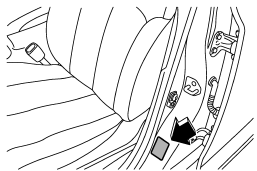
The vehicle placard is affixed to the driver’s side B-pillar.
Example:
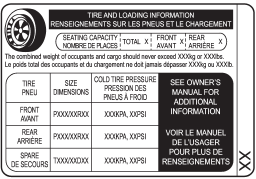
The vehicle placard shows original tire size, recommended cold tire inflation pressure on each tire at maximum loaded vehicle weight, seating capacity and loading information.
Adverse safety consequences of under-inflation
Driving at high speeds with excessively low tire pressures can cause the tires to flex severely and to rapidly become hot. A sharp increase in temperature could cause tread separation, and failure of the tire(s). Possible resulting loss of vehicle control could lead to an accident.
Measuring and adjusting air pressure to achieve proper inflation
Check and, if necessary, adjust the pressure of each tire (including the spare) at least once a month and before any long journey. Check the tire pressures when the tires are cold. Use a pressure gauge to adjust the tire pressures to the specific values. Driving even a short distance warms up the tires and increases the tire pressures. Also, the tire pressures are affected by the outside temperature. It is best to check tire pressure outdoors before driving the vehicle. When a tire becomes warm, the air inside it expands, causing the tire pressure to increase. Be careful not to mistakenly release air from a warm tire to reduce its pressure.
Glossary of tire terminology
● Accessory weight
The combined weight (in excess of those standard items which may be replaced) of automatic transmission, power steering, power brakes, power windows, power seats, radio, and heater, to the extent that these items are available as factory-installed equipment (whether installed or not).
● Bead
The part of the tire that is made of steel wires, wrapped or reinforced by ply cords and that is shaped to fit the rim.
● Bead separation
A breakdown of the bond between components in the bead.
● Bias ply tire
A pneumatic tire in which the ply cords that extend to the beads are laid at alternate angles substantially less than 90 degrees to the centerline of the tread.
● Carcass
The tire structure, except tread and sidewall rubber which, when inflated, bears the load.
● Chunking
The breaking away of pieces of the tread or sidewall.
● Cold tire pressure
The pressure in a tire that has been driven less than 1 mile or has been standing for three hours or more.
● Cord
The strands forming the plies in the tire.
● Cord separation
The parting of cords from adjacent rubber compounds.
Cracking
Any parting within the tread, sidewall, or inner liner of the tire extending to cord material.
● Curb weight
The weight of a motor vehicle with standard equipment including the maximum capacity of fuel, oil and coolant, and if so equipped, air conditioning and additional weight optional engine.
● Extra load tire
A tire designed to operate at higher loads and higher inflation pressure than the corresponding standard tire.
● Groove
The space between two adjacent tread ribs.
● Innerliner
The layer(s) forming the inside surface of a tubeless tire that contains the inflating medium within the tire.
● Innerliner separation
The parting of the innerliner from cord material in the carcass.
● Intended outboard sidewall (1) The sidewall that contains a whitewall, bears white lettering or bears manufacturer, brand, and/or model name molding that is higher or deeper than the same molding on the other sidewall of the tire, or
(2) The outward facing sidewall of an asymmetrical tire that has a particular side that must always face outward when mounting on a vehicle.
● Light truck (LT) tire
A tire designated by its manufacturer as primarily intended for use on lightweight trucks or multipurpose passenger vehicles.
● Load rating
The maximum load that a tire is rated to carry for a given inflation pressure.
● Maximum inflation pressure
The maximum cold inflation pressure to which a tire may be inflated.
● Maximum load rating
The load rating for a tire at the maximum permissible inflation pressure for that tire.
● Maximum loaded vehicle weight The sum of:
(a) Curb weight
(b) Accessory weight
(c) Vehicle capacity weight
(d) Production options weight
● Maximum permissible inflation pressure
The maximum cold inflation pressure to which a tire may be inflated.
● Measuring rim
The rim on which a tire is fitted for physical dimension requirements.
● Normal occupant weight
150 lbs (68 kg) times the number of occupants specified in the second column of Table 1 that is appended to the end of this section.
● Occupant distribution
Distribution of occupants in a vehicle as specified in the third column of Table 1 that is appended to the end of this section.
● Open splice
Any parting at any junction of tread, sidewall, or innerliner that extends to cord material.
● Outer diameter
The overall diameter of an inflated new tire.
● Overall width
The linear distance between the exteriors of the sidewalls of an inflated tire, including elevations due to labeling, decorations, or protective bands or ribs.
● Passenger car tire
A tire intended for use on passenger cars, multipurpose passenger vehicles, and trucks, that have a gross vehicle weight rating (GVWR) of 10,000 lbs (4,535 kg) or less.
● Ply
A layer of rubber-coated parallel cords.
● Ply separation
A parting of rubber compound between adjacent plies.
● Pneumatic tire
A mechanical device made of rubber, chemicals, fabric and steel or other materials, that, when mounted on an automotive wheel, provides the traction and contains the gas or fluid that sustains the load.
● Production options weight
The combined weight of those installed regular production options weighing over 5.1 lbs (2.3 kg) in excess of those standard items which they replace, not previously considered in curb weight or accessory weight, including heavy duty brakes, ride levelers, roof rack, heavy duty battery, and special trim.
● Radial ply tire
A pneumatic tire in which the ply cords that extend to the beads are laid at substantially 90 degrees to the centerline of the tread.
● Recommended inflation pressure The cold inflation pressure recommended by a vehicle manufacturer.
● Reinforced tire
A tire designed to operate at higher loads and at higher inflation pressures than the corresponding standard tire.
● Rim
A metal support for a tire or a tire and tube assembly upon which the tire beads are seated.
● Rim diameter
Nominal diameter of the bead seat.
● Rim size designation
Rim diameter and width.
● Rim type designation
The industry of manufacturer’s designation for a rim by style or code.
● Rim width
Nominal distance between rim flanges.
● Section width
The linear distance between the exteriors of the sidewalls of an inflated tire, excluding elevations due to labeling, decoration, or protective bands.
● Sidewall
That portion of a tire between the tread and bead.
● Sidewall separation
The parting of the rubber compound from the cord material in the sidewall.
● Test rim
The rim on which a tire is fitted for testing, and it may be any rim listed as appropriate for use with that tire.
● Tread
That portion of a tire that comes into contact with the road.
● Tread rib
A tread section running circumferentially around a tire.
● Tread separation
Pulling away of the tread from the tire carcass.
● Treadwear indicators (TWI) The projections within the principal grooves designed to give a visual indication of the degrees of wear of the tread.
● Vehicle capacity weight
The rated cargo and luggage load plus 150 lbs (68 kg) times the vehicle’s designated seating capacity.
● Vehicle maximum load on the tire
Load on an individual tire that is determined by distributing to each axle its share of the maximum loaded vehicle weight and dividing by two.
● Vehicle normal load on the tire
Load on an individual tire that is determined by distributing to each axle its share of the curb weight, accessory weight, and normal occupant weight (distributed in accordance with Table 1 that is appended to the end of this section) and dividing by 2.
● Wheel-holding fixture
The fixture used to hold the wheel and tire assembly securely during testing.
Table 1 — Occupant loading and distribution for vehicle normal load for various designated seating capacities
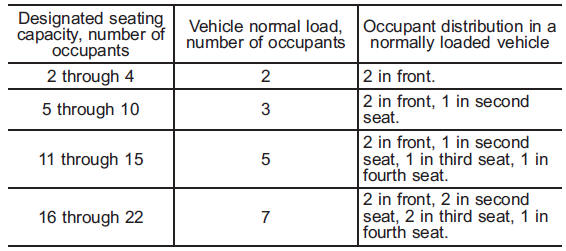
Tire care – maintenance and safety practices
● Check on a daily basis that the tires are free from serious damage, nails, and stones. At the same time, check the tires for abnormal wear.
● Inspect the tire tread regularly and replace the tires before their tread wear indicators become visible. When a tire’s tread wear indicator becomes visible, the tire is worn beyond the acceptable limit and must be replaced immediately. With a tire in this condition, driving at even low speeds in wet weather can cause the vehicle to hydroplane. Possible resulting loss of vehicle control can lead to an accident.
● To maximize the life of each tire and ensure that the tires wear uniformly, it is best to rotate the tires every 7,500 miles (12,000 km). Rotating the tires involves switching the front and rear tires on the right-hand side of the vehicle and similarly switching the front and rear tires on the left-hand side of the vehicle. (Each tire must be kept on its original side of the vehicle.) Replace any damaged or unevenly worn tire at the time of rotation. After tire rotation, adjust the tire pressures and make sure the wheel nuts are correctly tightened. For information about the tightening torque and tightening sequence for the wheel nuts, refer to “Flat tires” F9-6.
Vehicle load limit – how to determine
The load capacity of your vehicle is determined by weight, not by available cargo space. The load limit of your vehicle is shown on the vehicle placard attached to the driver’s side B-pillar. Locate the statement “The combined weight of occupants and cargo should never exceed XXX kg or XXX lbs” on your vehicle’s placard.
The vehicle placard also shows seating capacity of your vehicle. The total load capacity includes the total weight of driver and all passengers and their belongings, any cargo, any optional equipment such as a trailer hitch, roof rack or bike carrier, etc., and the tongue load of a trailer. Therefore cargo capacity can be calculated by the following method.
Cargo capacity = Load limit − (total weight of occupants + total weight of optional equipment + tongue load of a trailer (if applicable))
For towing capacity information and weight limits, refer to “Trailer towing” F8-19.
Calculating total and load capacities varying seating configurations
Calculate the available load capacity as shown in the following examples:
Example 1A
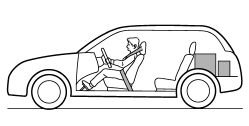
Vehicle capacity weight of the vehicle is 800 lbs (363 kg), which is indicated on the vehicle placard with the statement “The combined weight of occupants and cargo should never exceed 363 kg or 800 lbs”.
For example, if the vehicle has one occupant weighing 154 lbs (70 kg) plus cargo weighing 551 lbs (250 kg).
1. Calculate the total weight.

2. Calculate the available load capacity by subtracting the total weight from the vehicle capacity weight of 800 lbs (363 kg).
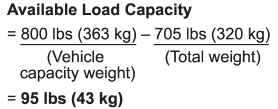
3. The result of step 2 shows that a further 95 lbs (43 kg) of cargo can be carried.
Example 1B
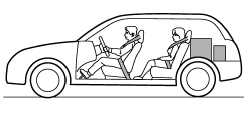
For example, if a person weighing 176 lbs (80 kg) now enters the same vehicle (bringing the number of occupants to two), the calculations are as follows:
1. Calculate the total weight.
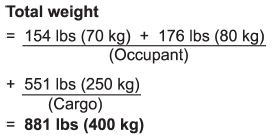
2. Calculate the available load capacity.
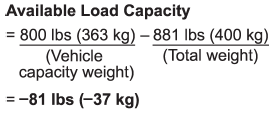
3. The total weight now exceeds the capacity weight by 81 lbs (37 kg), so the cargo weight must be reduced by 81 lbs (37 kg) or more.
Example 2A

Vehicle capacity weight of the vehicle is 800 lbs (363 kg), which is indicated on the vehicle placard with the statement “The combined weight of occupants and cargo should never exceed 363 kg or 800 lbs”.
For example, the vehicle has one occupant weighing 165 lbs (75 kg) plus cargo weighing 265 lbs (120 kg). In addition, the vehicle is fitted with a trailer hitch weighing 22 lbs (10 kg), to which is attached a trailer weighing 1,764 lbs (800 kg). 10% of the trailer weight is applied to the trailer tongue (i.e. Tongue load = 176 lbs (80 kg)).
1. Calculate the total weight.
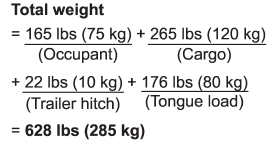
2. Calculate the available load capacity.
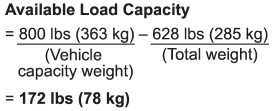
3. The result of step 2 shows that a further 172 lbs (78 kg) of cargo can be carried.
Example 2B

For example, if a person weighing 143 lbs (65 kg) and a child weighing 40 lbs (18 kg) now enter the same vehicle (bringing the number of occupants to three), and a child restraint system weighing 11 lbs (5 kg) is installed in the vehicle for the child to use, the calculations are as follows:
1. Calculate the total weight.
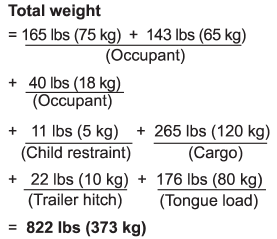
2. Calculate the available load capacity.
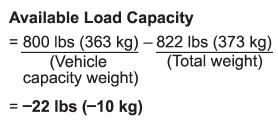
3. The total weight now exceeds the capacity weight by 22 lbs (10 kg), so the cargo weight must be reduced by 22 lbs (10 kg) or more.
Determining compatibility of tire and vehicle load capacities
The sum of four tires’ maximum load ratings must exceed the maximum loaded vehicle weight (“GVWR”). In addition, sum of the maximum load ratings of two front tires and of two rear tires must exceed each axle’s maximum loaded capacity (“GAWR”). Original equipment tires are designed to fulfill those conditions.
The maximum loaded vehicle weight is referred to Gross Vehicle Weight Rating (GVWR). And each axle’s maximum loaded capacity is referred to Gross Axle Weight Rating (GAWR). The GVWR and each axle’s GAWR are shown on the vehicle certification label affixed to the driver’s door.
The GVWR and front and rear GAWRs are determined by not only the maximum load rating of tires but also loaded capacities of the vehicle’s suspension, axles and other parts of the body.
Therefore, this means that the vehicle cannot necessarily be loaded up to the tire’s maximum load rating on the tire sidewall.
Adverse safety consequences of overloading on handling and stopping and on tires
Overloading could affect vehicle handling, stopping distance, vehicle and tire as shown in the following. This could lead to an accident and possibly result in severe personal injury.
● Vehicle stability will deteriorate.
● Heavy and/or high-mounted loads could increase the risk of rollover.
● Stopping distance will increase.
● Brakes could overheat and fail.
● Suspension, bearings, axles and other parts of the body could break or experience
accelerated wear that will shorten vehicle life.
● Tires could fail.
● Tread separation could occur.
● Tire could separate from its rim.
Steps for Determining Correct Load Limit
1. Locate the statement “The combined weight of occupants and cargo should never exceed XXX pounds” on your vehicle’s placard.
2. Determine the combined weight of the driver and passengers that will be riding in your vehicle.
3. Subtract the combined weight of the driver and passengers from XXX kilograms or XXX pounds.
4. The resulting figure equals the available amount of cargo and luggage load capacity. For example, if the “XXX” amount equals 1,400 lbs (635 kg) and there will be five- 150 lbs (68 kg) passengers in your vehicle, the amount of available cargo and luggage load capacity is 650 lbs (1,400 − 750 (5 6 150) = 650 lbs).
5. Determine the combined weight of luggage and cargo being loaded on the vehicle. That weight may not safely exceed the available cargo and luggage load capacity calculated in Step 4.
6. If your vehicle will be towing a trailer, load from your trailer will be transferred to your vehicle. Consult this manual to determine how this reduces the available cargo and luggage load capacity of your vehicle.


